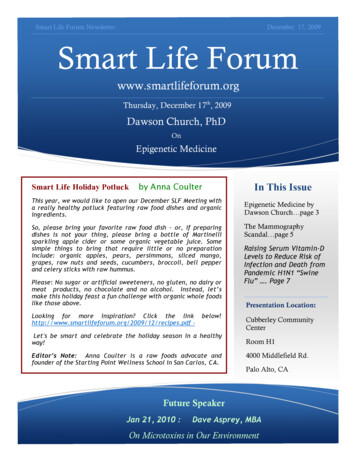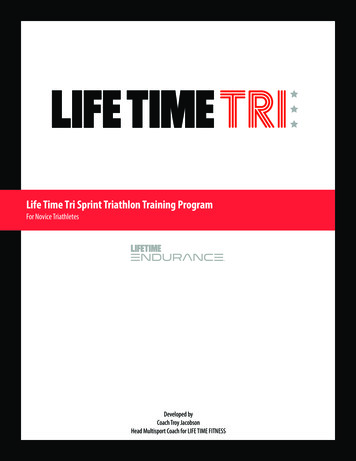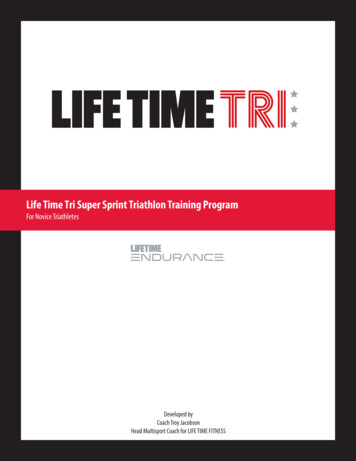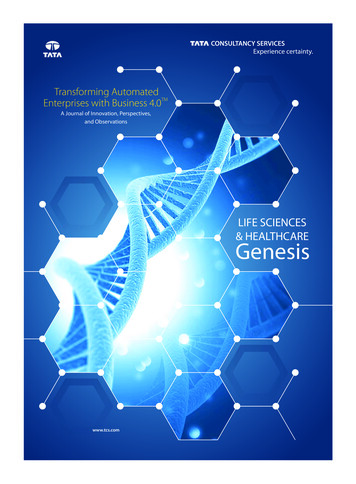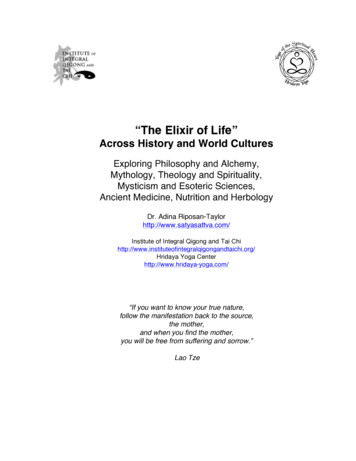
Transcription
“The Elixir of Life”Across History and World CulturesExploring Philosophy and Alchemy,Mythology, Theology and Spirituality,Mysticism and Esoteric Sciences,Ancient Medicine, Nutrition and HerbologyDr. Adina Riposan-Taylorhttp://www.satyasattva.com/Institute of Integral Qigong and Tai rg/Hridaya Yoga Centerhttp://www.hridaya-yoga.com/“If you want to know your true nature,follow the manifestation back to the source,the mother,and when you find the mother,you will be free from suffering and sorrow.”Lao Tze
ContentsI. IntroductionI.1. Concept and EvolutionI.2. Names and Forms of the TermII. Philosophers' StoneII.1. Concept and InterpretationII.2. Theories of Creation and CosmogonyII.3. Cintamani in Buddhism and HinduismII.4. Practical ClaimsIII. Thoth and Hermes Trismegistus, in Egyptian and Greek MythologyIV. Ambrosia, Nectar, and Ichor, in Greek MythologyIV.1. AmbrosiaIV.2. NectarIV.3. IchorV.1. Amrit, Soma, and HaomaV.1. Amrit (or Amrita)V.1.1. The Legend of AmritV.1.2. Amrita in Tibetan and Chinese Buddhism, Sikhism, and Yogic PhilosophyV.2. SomaV.2.1. The Plant and the Holy DrinkV.2.2. The Legend of the Warrior-God IndraV.2.3. Soma in Yogic PhilosophyV.3. Haoma in ZoroastrianismVI. Ancient and Traditional MedicineVI.1. Ayurvedic MedicineVI.2. Siddha MedicineVI.3. Traditional Chinese MedicineVII. Agni, Ojas, and TejasVII.1. Agni – Inner FireVII.2. Ojas – the Vital Nectar of LifeVII.3. Tejas – the Elixir of TransmutationVIII. The Absolute Darkness and the Return to OnenessVIII.1. Darkness Retreat Traditions – a Path to Enlightenment and ImmortalityVIII.2. “Darkness” and “Blackness” – Alchemic SymbolsIX. Golden Elixir in DaoismIX.1. Daoist Alchemy – Phases and EvolutionIX.2. Neidan and the Golden ElixirANNEX: The Golden Elixir Legend through the “7 Precious Gestures” Qigong Form
I. IntroductionI.1. Concept and EvolutionGenerically, the Elixir of (Eternal) Life, or the Elixir of Immortality, was a term usedto represent a mythical alchemic potion which would presumably confer immortality,rejuvenation and ageless life to the person consuming it – possibly if ingesting it at acertain time or from a certain cup. The promise of the elixir was “eternal life” and/or“eternal youth”. In some traditions, the elixir was also believed to have the power tocreate life. The purpose of the Alchemists over the centuries and across cultures wasto seek for the ways and methods of formulating the elixir. Sometimes, in alchemictraditions and literature, the elixir was equated with the “philosopher's stone”. In othercultures, a fruit or other type of food or a drink would have the same purpose andwould be granted the same powers.However, as we seek for the deeper meanings and analyze the more profound uses ofthe concept, we discover different dimensions of the term and different levels ofinterpretation. This paper will bring a gradual approach to the study, integrating all thedimensions of the concept, and progressing by exploring and understanding all thesides and angles of the elixir “story”.As an ingestible drink or food, we find variations of the concept of the elixir of eternallife – ranging from the mythical alchemic potion to a large variety of herbs, naturalmedicines and remedies, fruits, hallucinogenic mushrooms, and other foods and drinksthat were generically called “the food and the drink of the Gods”. They were used withthe promise of health and longevity, immortality, and creating or recovering life.Some of them were also used as entheogenic agents. An entheogen was apsychoactive chemical substance used in a spiritual context for “generating the divinewithin” (in religious, shamanic, spiritual rituals). Entheogens have been used forthousands of years and there are strongly established evidences (modern andanthropological) of their religious significance in a ritualized context. The entheogencould be synthesized from natural sources and may have induced psychological orphysiological altered states of consciousness, transcendence and revelation.Entheogens were used to supplement a wide range of practices, such as meditation,yoga, prayer, psychedelic and visionary art, chanting and music, traditional medicineand psychedelic therapy, witchcraft, magic, and psychonautics.The elixir of immortality is often seen as a metaphor for the spirit of God. In thatsense, it is the expression of the elevation of the spirit, a superior state ofconsciousness, and perfect body-mind-spirit integration. The elixir is thus seen as thefinest form of perfection, the culmination of enlightenment, and heavenly bliss. At thisstage in the study, we explore the dimension of spiritual knowledge, "religion ofknowledge", mystical enlightenment, or "insight”.
We largely speak about the broader philosophy and archetypal human mythologyrelated to the life and the transformation of an ascending person, centered aroundthe concept of the “elixir of immortality”, the “golden elixir” that was thought to confer“immortality” to the seekers of spiritual realms and self-realisation. The “elixir” isdepicted as the goal, the target, and the prize, pursued through persistent practice andcultivation of the right attitudes, the expression of the highest form of “cultivation”. The“golden elixir of immortality” is both the intent and the gift. But one cannot purchase it,one has to earn it. One has to deserve it, and acquire it, and the process requiresundergoing the steps and stages of proving the appropriate qualities, attitudes,persistence, determination, endurance, and the patience of the one who is ready for it;overall, those qualities of the initiate who has attained the level of transformation thatgrants one the privilege and the grace of receiving the elixir.The Gods – often appearing in these legends of the elixir across cultures – are seen,in this view, as archetypal representations of exceptional historical figures, “deified”evolved beings that have been – upon the success of their quests – wed as gods ordemi-gods. “Ambrosia”, for example, was sometimes defined as a reward for the onesthat had succeeded to complete the Gods’ quests and were thereby wed as Godsthemselves and accepted on Olympus.Sometimes the Gods are regarded as the embodiment of particular qualities andwisdoms of ascending beings, or even as forces of nature and specific energies ofthe Earth and the Cosmos that could be developed or assimilated by the seekers ofspirituality and enlightened beings, through persistent work, mind-body energycultivation, spiritual practice and commitment to righteous attitudes in life. In Daoistand Buddhist stories we find the ascending beings undergoing the quests in order tobe accepted at the Temple, where they would further prove readiness and beingworthy to be initiated and to eventually receive the “elixir of life”, the “pill of immortality”.I find it interesting and of crucial importance to explore with profound attention therange of mythological and spiritual archetypes and figures of divinity in order tounderstand their similar profiles and the common treats of the “divine”archetypes that could be linked to the self-realisation and/or the ingestion of the “Elixirof Life” – throughout world’s historical dramas, cultures, and philosophies.In most traditions, and typically at later stages in history, we then discover the “pill ofimmortality” as being the symbolic representation of the “Inner Elixir” – the mosthighly refined essence of self, our “true nature”, expressing the profound truth ofeternal being. We discover the “elixir of eternal life” as being directly related to theprofound inner transformation of the initiate, gradually occurring as the ascendingperson undergoes the process and the quest for finding and acquiring the elixir ofimmortality. Eventually, one discovers one already has it; it is inner, it is subtle, it is themost resilient self, that which is the most real, pure and perfect, the self infused withthe aspects of one’s nature that are indestructible.
The concept of the "Golden Elixir" and the archetypal human mythology of theascending person can be found in the Daoist, Buddhist, Vedic, Greek, Latinmythologies – to only mention a few – which all started with the "elixir" being seen asan ingestible potion thought to confer “immortality” and the access to "transcendence"and to the "higher soul", but further it was “turned inside” toward the inner planeand linked to the process of inner evolution – e.g., the Waidan (Daoist ExternalAlchemy) transitioned to Neidan (Daoist Internal Alchemy) and the "elixir" became the“inner elixir” sought to be created, or developed, or simply re-discovered (in the versionof Liu Yiming, which stated that we already had it in ourselves).The Elixir now becomes “the goal” inner essence to be generated through theinner alchemical practice. That's where practice comes in place – combining thespiritual teachings with physiological practices, nutrition, healthy life-style and righteouslife attitudes. It further addresses concepts that can be found with similar connotationsacross cultures – such as the Yin and Yang, the Elements (the simplest essential partsand principles of which anything can consist), and the “World’s Soul” in direct relationto the individual souls and the human body.Last but not the least, we find pointers toward the alchemic tantric practices of sexualenergy transmutation (e.g. in Vedic and Daoist traditions), put in the frame of“Reversing the Sense of Cosmogony”. Transmutation (and sublimation) are presentedas a way of refining the raw vital life force (or essence) and transforming it intosuperior forms of spiritual energy – that would further develop the spirit and lead it intothe Emptiness. The concept of the elixir of eternal life comes closely related with thesepractices of alchemic transmutation, revealing the ultimate essence of our being, the“true nature” and “eternal self”.I.2. Names and Forms of the TermThe word “elixir” was not used until the 7th century A.D. and derives from the Arabicname for miracle substances, "al iksir". There are hundreds of known names for the“elixir”, found in various cultures and at various times in history, in the extensive sensecomprising: the Philosopher's Stone (legendary alchemical symbol), Cintamani (theequivalent of the Philosopher's Stone in Buddhism and Hinduism), Amrit Ras (orAmrita, the Indian name for “immortality juice"), Maha Ras (“the great juice”), SomaRas ("juice of Soma”), Haoma (the version of Soma in Zoroastrianism), Hum (theMiddle Persian form of Soma and Haoma), Aab-i-Hayat (Persian name for "water oflife”), Aab-Haiwan, Dancing Water, Chasma-i-Kausar ("Fountain of Bounty," whichMuslims believe to be located in Paradise), Mansarover (Pool of Nectar, or "mind lake"- the holy lake at the foot of Mt. Kailash in Tibet, close to the source of the Ganges),Ambrosia (the “favourite food or drink” of the gods or demigods in ancient Greekmythology, Nectar (similar to Ambrosia, the Latinized version of néktar, and
etymologically meaning “overcoming death”), the Wine of Dionysus, etc. Other legendsrefer to the myths of Thoth and Hermes Trismegistus, both of whom in various talesare said to have drunk "the white drops" (liquid gold) and thus achieved immortality, asmentioned in one of the Nag Hammadi texts.In Christianity, the term “Water of Life" is used in the context of living water, specificreferences appearing in the Book of Revelation and the Gospel of John. Jesus'sreference to the “Water of Life” or the “Fountain of Life”, refers to the Holy Spirit: “Butwhoever drinks the water I give him will never thirst. Indeed, the water I give him willbecome in him a spring of water welling up to eternal life.” (John 4:14); the term is alsoused when water is poured during Baptismal prayers, praying for the Holy Spirit (”Giveit the power to become water of life”).II. Philosophers' StoneII.1. Concept and InterpretationThe Philosophers' Stone (or stone of the philosophers) is a legendary alchemicalsubstance that was thought to have mystical properties and magical powers. Inliterature, it was generally granted the power to heal diseases and to increase longevityfor anybody who would ingest a piece of it. It was also conferred the alchemicalproperty of transmuting base metals (e.g., lead) into gold or silver, which was at thecore of the alchemy ambitions for centuries and the most pursued goal. The gamut ofwork and writings that were developed in the effort to discover the philosophers' stoneformed the Magnum Opus or the "Great Work”.The theoretical roots and the first mention of the philosophers' stone in writing comesfrom early Greek Alchemy and philosophy (Cheirokmeta by Zosimos of Panopolis, c.300 AD), in Greek language (translations into Syriac or Arabic are known), butlegendary claims that send us back to Adam who is believed to have acquired theknowledge of the stone directly from God. This knowledge was presumably transmittedthrough biblical patriarchs who, according to the legend, owed their longevity to thestone. There are also comparisons made between the legend of the philosophers'stone and he biblical history of the Temple of Solomon.There are many speculations regarding the stone’s composition and source, especiallydue to the many names and properties that were attributed to it. Some authors inAlchemy also suggest that the description is metaphorical and that, also it is called astone, it doesn’t necessarily look like a stone. There are a range of possiblesuggestions for its nature and composition, such as metals, plants, rocks, chemicalcompounds, and bodily products (e.g., hair, urine, eggs). A mythical key element ofwhich the philosopher's stone was believed to be composed was called “carmot”.
Another view on Alchemy was brought by the esoteric hermetic alchemists whorejected the idea of work on substances. They turned their search for thephilosophers' stone inward. However, esoteric and exoteri
Alchemy) transitioned to Neidan (Daoist Internal Alchemy) and the "elixir" became the “inner elixir” sought to be created, or developed, or simply re-discovered (in the version of Liu Yiming, which stated that we already had it in ourselves). The Elixir now becomes



